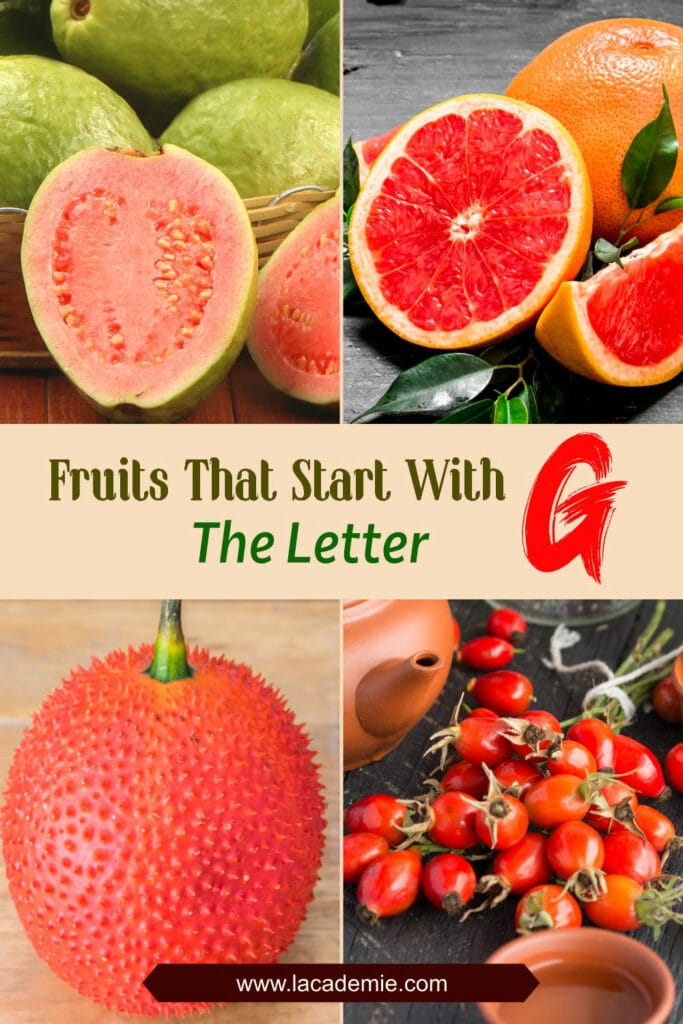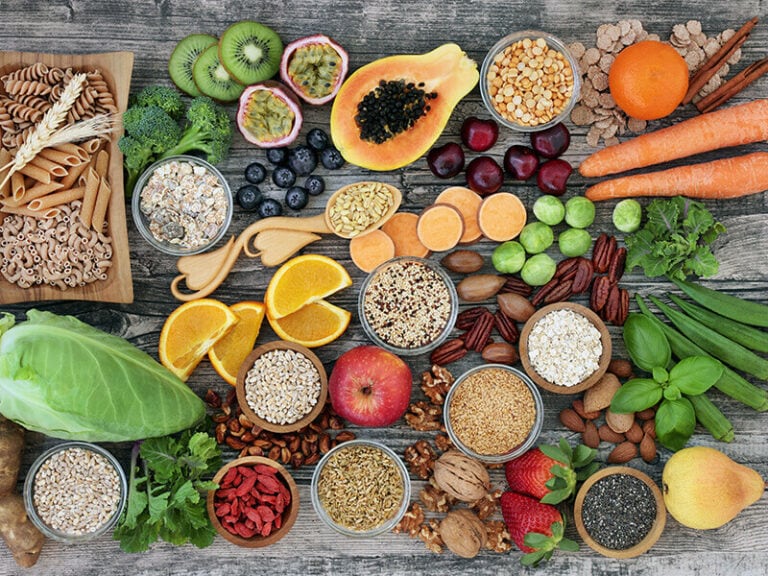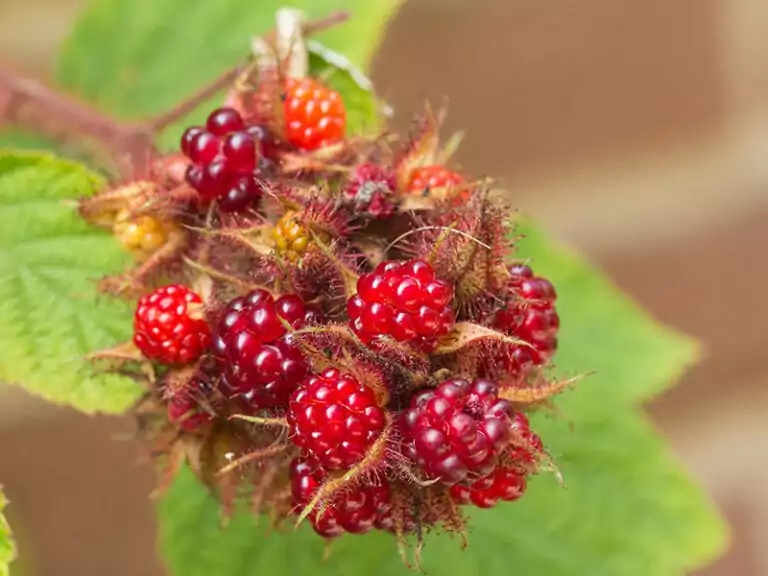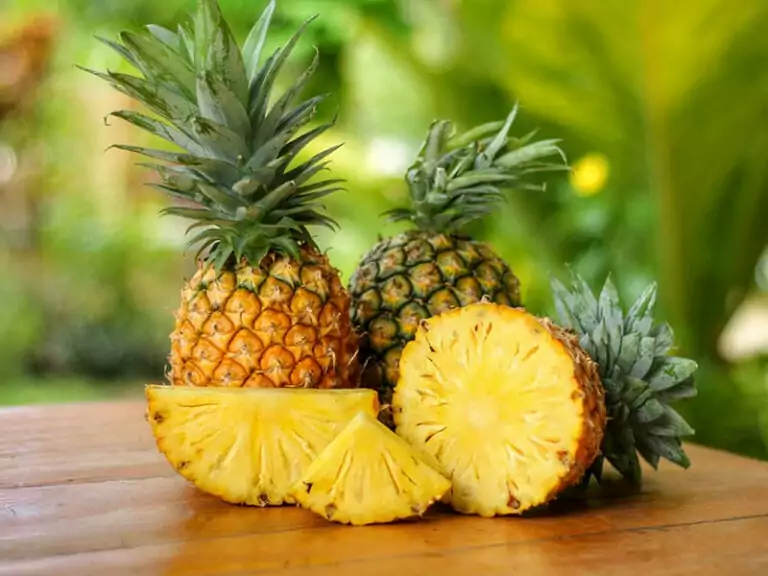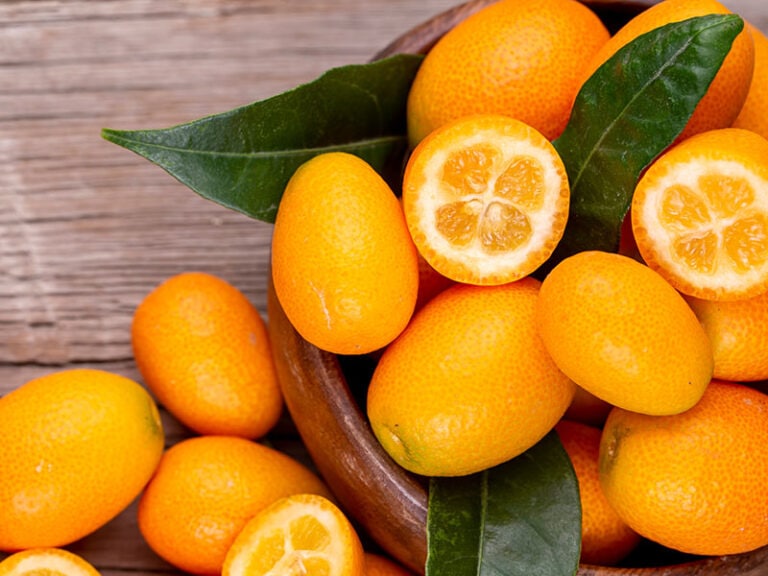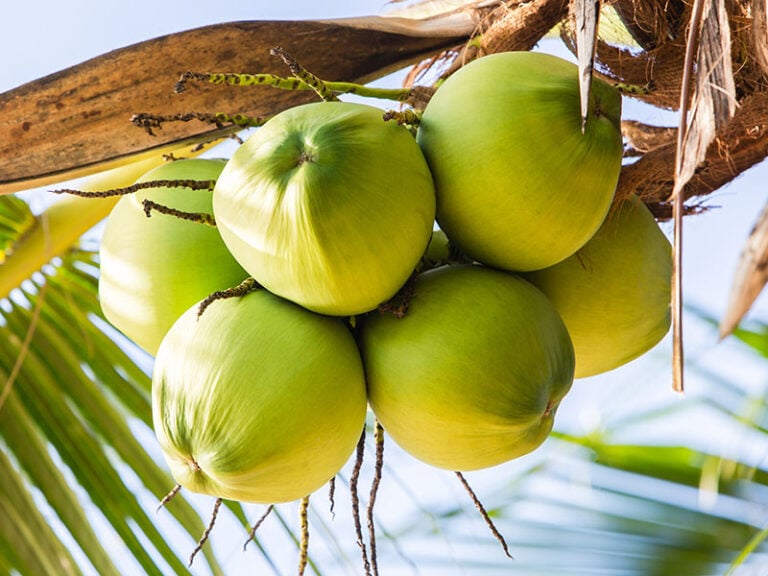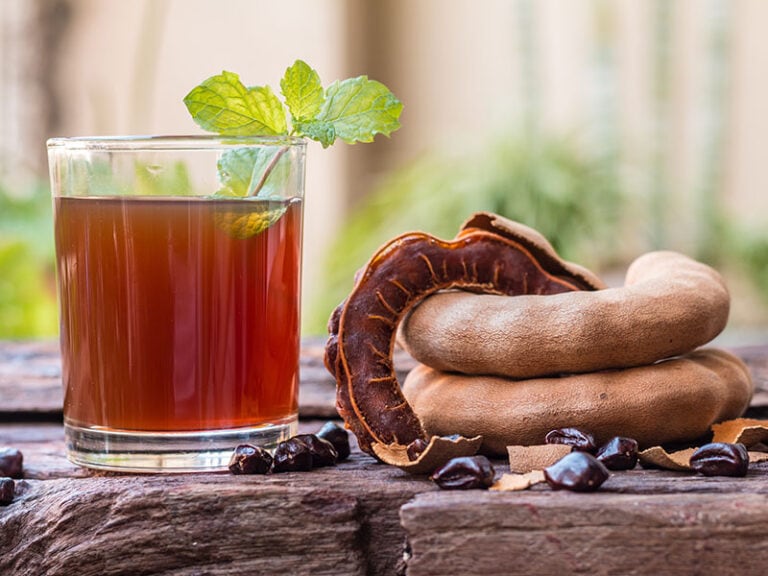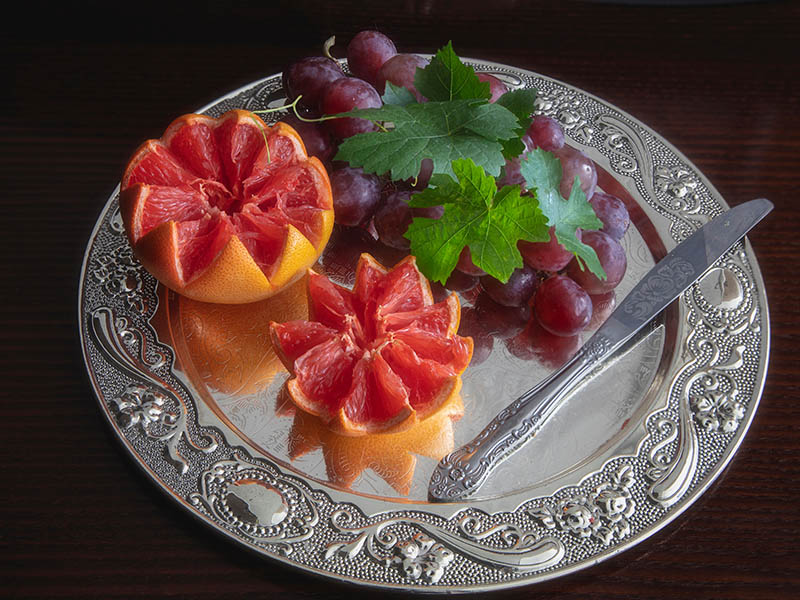
You have checked the dictionary; you have also googled it, but “fruits that start with G” is such a hard biscuit to bite. No problem! This post will introduce you to a list of G-fruits that will gain you a lot of wisdom.
Besides giving you their names, this post will also provide you with their origins, nutrients information, and taste. So now, let’s sit back, relax, and figure out what fruits begin with the letter ‘G’.
You Probably Can Name These Fruits That Start With G
Naming these fruits is just a piece of cake for you. They are common and familiar. You can see them almost every day and definitely every time you go to the supermarket. So, are you ready to learn more about their hometown and intrinsic nature?
1. Grape
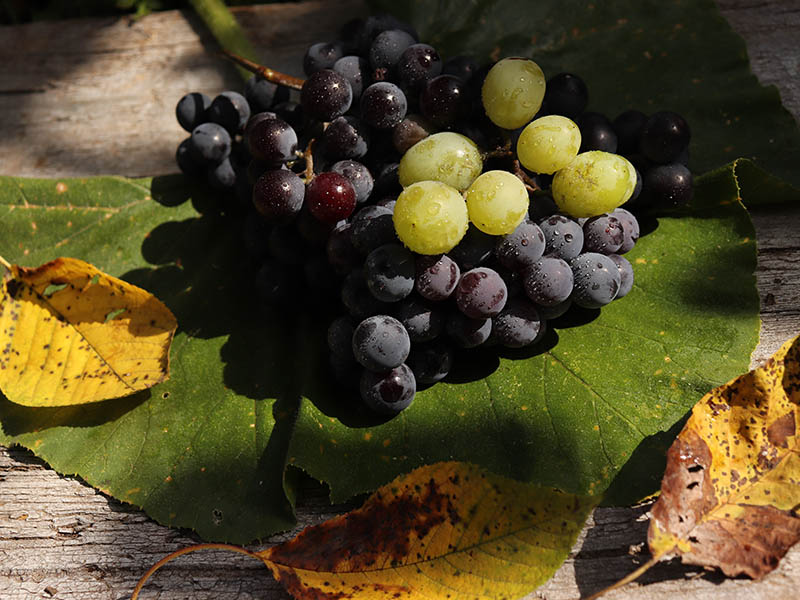
This fruit is amazing because of how useful it is. Grapes can be eaten fresh, or you can dry them to make raisins. You can use grapes to make dessert, wine, jam, or even vinegar.
People extract grape seeds to produce grapeseed oil, which is an extremely versatile and nutritious cooking ingredient. If you want to give it a try, make sure to buy the highest quality grapeseed oil.
You can see various grape types all around the world – from Asia to Europe, from Africa to Australia. Humans have learned how to grow grapes since 6,500 B.C. Until now, the grape culture is still expanding and growing, with Spain and France ranking first and second in winemaking.
Not only tasty, but grapes are also very nutritious. They contain potassium which helps to keep your heart healthy. They are rich in Vitamin E, so they will also take care of your skin.
Eating grapes can ease inflammation in your body. Therefore, they boost your immunity and protect you from cancers.
Grape wine is also very easy to make. This spicy juice can improve your appetites and help you sleep better at night. You can prepare homemade grape wine with just a jar, fresh grapes, some sugar, and water.
You can impress your friends with your homemade wine at their party.
2. Grapefruit
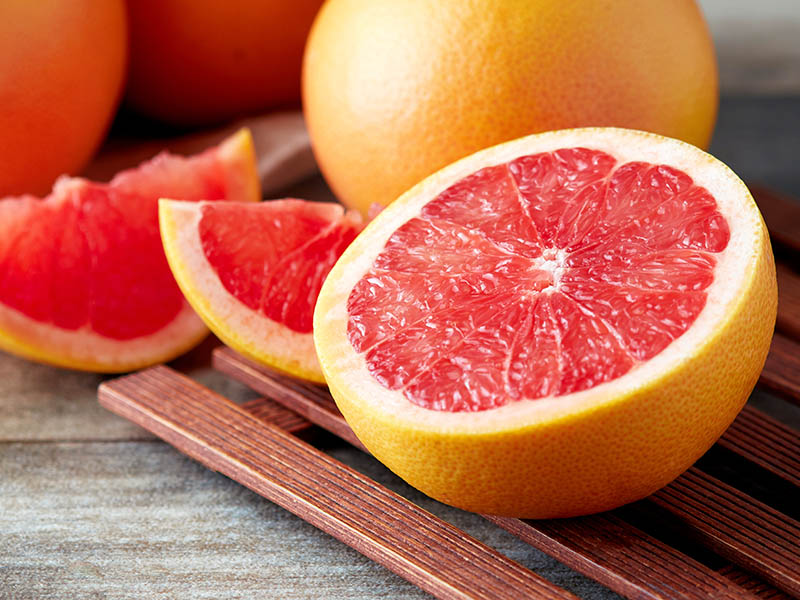
You might think grapefruit and grape are cousins or something like that, but they actually aren’t. Grapefruit is a tropical citrus fruit that is a natural hybrid of Indonesian pomelo and Jamaican sweet orange.
Like other citrus fruit varieties, grapefruit has an acidic taste. Since this fruit is a child of sweet orange and pomelo, it has a range of flavors from sour to sweet and bitter. Grapefruit also has a fragrant aroma from its peel since this is the part where all the scents concentrate.
Grapefruit is rich in antioxidants; for that reason, grapefruit is good for your immunity. Antioxidants prevent your body from developing cancers and help you to lose weight. Its peel can produce essential oil, which is extremely good for your hair.
On the other hand, various grapefruit types are incompatible with some medical substances. So if you are taking medication, you should read the labels carefully to avoid overdose. Also, eating grapefruit is not really good for your tooth enamel since it can cause erosion.
3. Guava
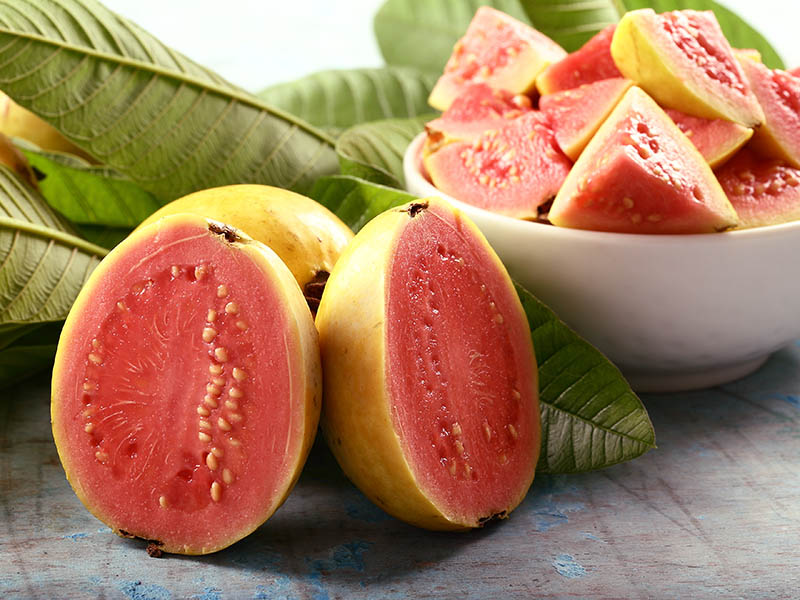
Guava is a tropical fruit that you can find in most subtropical and tropical regions like South Asia, tropical Africa, South America, and Central North America. People believe guava originated from Mexico and was spread around the world by birds and humans.
All types of guava have the same light green outside, but their inside has various colors from pink to white. Guavas have an exquisite flavor that many adore. Simply speaking, they taste sweet and fresh, and you can eat them raw or make salad from them.
When stored correctly, guavas have a quite remarkable shelf life. This fruit contains a lot of vitamin C and fiber. They are very good for pregnant women and people with diabetes. Guava seeds can also be used to make oil or for cosmetic products.
4. Gooseberry
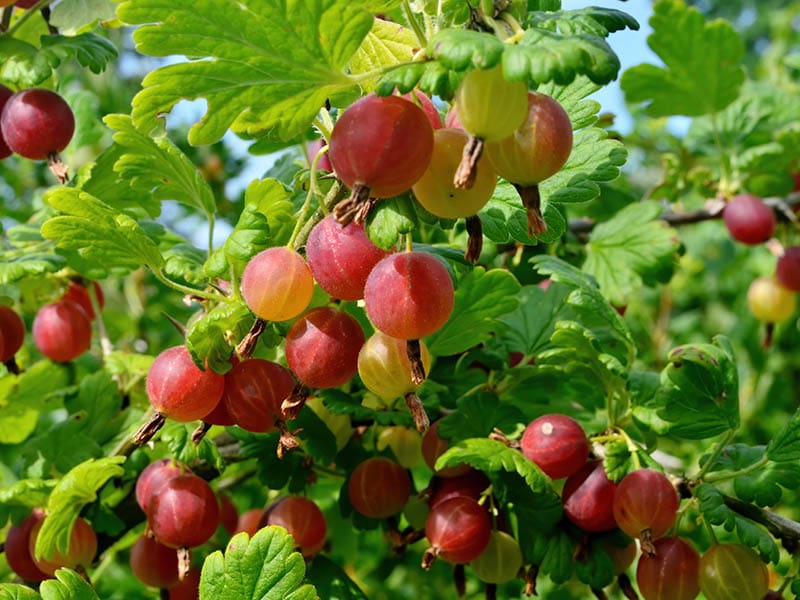
This interesting fruit looks like mini Chinese lanterns on a tree. They have many colors, from green, purple, orange to black, white, or yellow. Some people eat them raw, but most of the time, they turn them into wine, jellies, pies, or other desserts.
They were found around West Asia and Europe; they often grow naturally in places with cozy climates like the mountains. Gooseberries are grown in bushes, and they were common back in the 19th century.
5. Granny Smith Apple
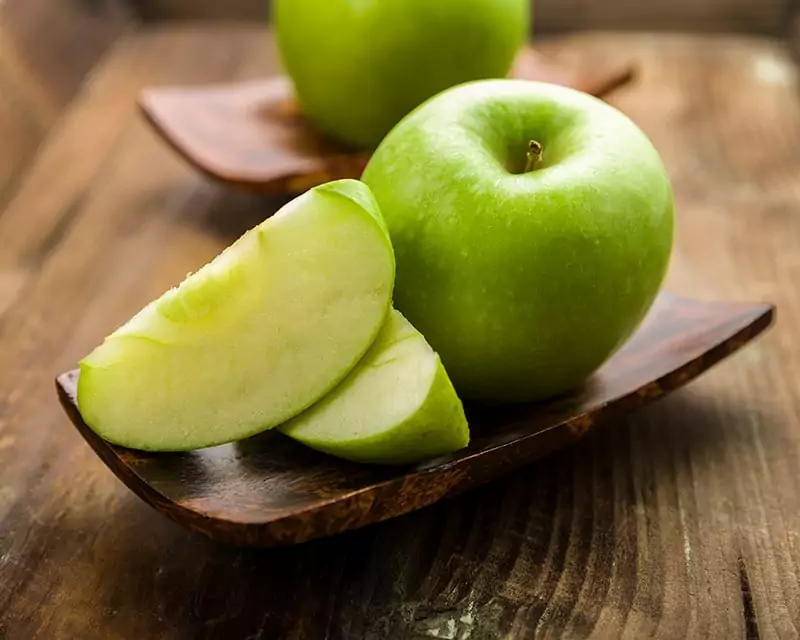
This green apple is very famous in the USA, but it actually originated in Australia. Granny Smith won third place at the most popular apple types ranking in the USA in 2019. It provides you with a sour and fresh taste that you can eat raw or use in pies.
A lady named Maria Ann Smith discovered this new apple species with her husband. Later in her life, she played an impactful role in the community, gaining her the title “Granny”. And to tribute to her respectfully, people have called this apple “Granny Smith”.
Granny Smith gives you healthy sugars (sucrose, fructose, and glucose) and a lot of vitamin E, vitamin C, and vitamin A. It contains high antioxidants, so it helps fight against chronic inflammation. Granny Smith is also high in fiber; therefore, it’s good for your intestinal health.
Learn how to make a classic grandma’s apple pie with Granny Smith.
6. Gorham Pear
Gorham pear was born in 1910 by the New York State Agricultural Experiment Station. They created a mix of the Barlett pear and the Josephine de Malines pear. Gorham was so much more resistant to pests and diseases than its parents.
Gorham is a seasonal fruit and can only be seen from September to October in the USA. It does not have a vivid kind of color for dressing, but it owns a humble brown-green outside and a bright yellow inside.
Gorham is also different from other typical pears since it does not come with a neck; it has an almost cone shape.
Gorham pear is a high-quality pear with its sweetness and juiciness with a hint of acidity. This pear can be used to make canned pear or eaten fresh. Like other pears, Gorham pear is filled with water, fiber, and antioxidants.
7. Gala Apple Or Grapple
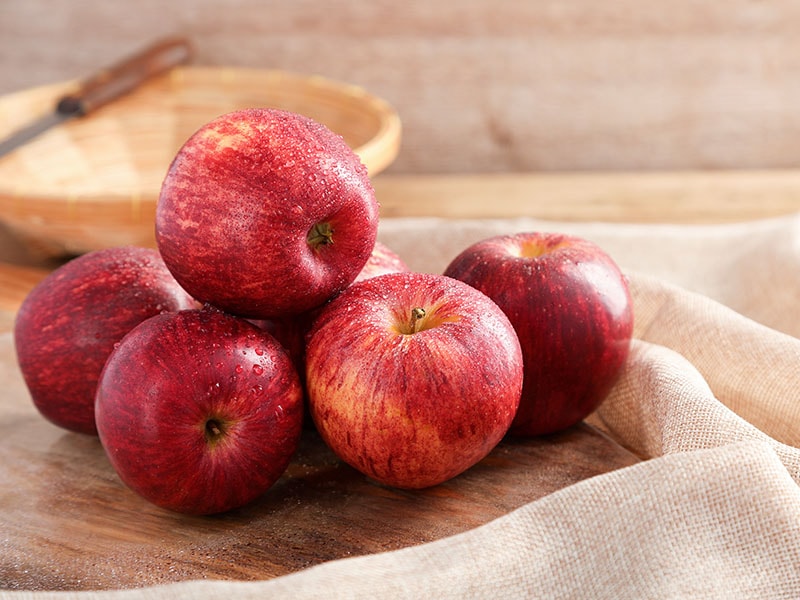
Gala apple (or grapple) is one of the most popular apples in the USA. Although its origin is New Zealand, that did not stop Gala from stealing apple lovers’ hearts, and in 2018, Gala beat Red Delicious and became the highest apple cultivation in America.
A man named “James Hutton Kidd” formed the Gala apple by breeding two apple kinds, Golden Delicious and Kidd’s Orange Sweet. It’s among the sweetest apples that you can find. Gala dresses in red and has a sweet, mild taste, and it’s also very aromatic.
Besides being a perfect dessert like an apple pie or just a simple dish of sliced apples, Gala can be an ingredient for applesauce since it’s soft and sweet. In addition, you can buy Gala apples throughout the year, so you can enjoy this tasty fruit anytime you want.
These G-Fruits Actually Make You Use Your Brain To Think Hard
This part of the post contains some names that you might not know or just do not know their names even though you meet these fruits every day in the supermarket. Some of them are from Asia or South America.
8. Goji Berry
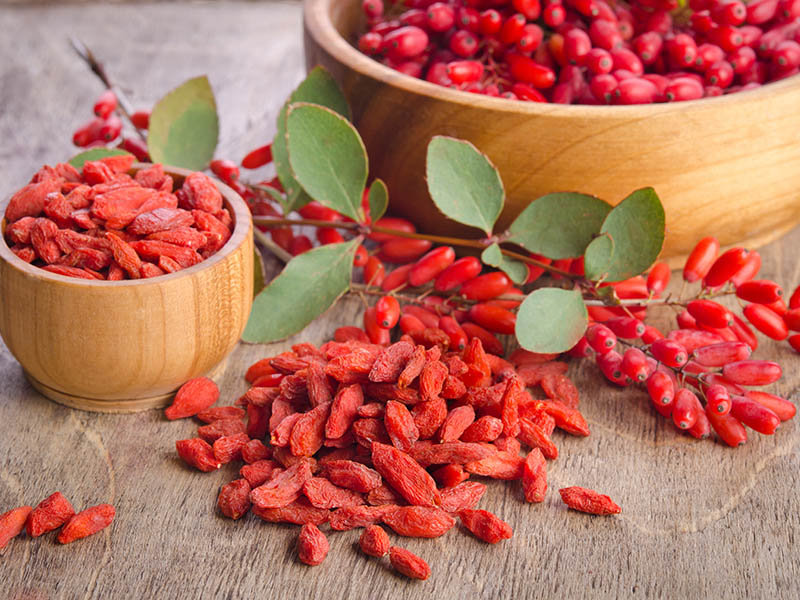
Goji berries, or wolfberries, are like red pouches of medicinal substances. They have been used as precious medicines since the 3rd century in Japan, Korea, and China. The Western countries started to notice their existence in the 21st century.
They are rich in vitamin C, which helps improve your eye health and people with weight problems. At the same time, it is not suggested to eat this fruit if you are taking blood thinner, diabetes medication, or high blood pressure medication.
In the supermarket, you might see Goji berries in packages of dried fruits or in powder form. They can replace raisins in culinary, and their seeds can also be pressed to extract oil.
There were some controversies where businesses claimed that Goji was a cure for cancers, which is, until now, still an unproven statement.
Goji berry tree is a great decoration, so here’s an instruction on how to grow it.
9. Guavaberry
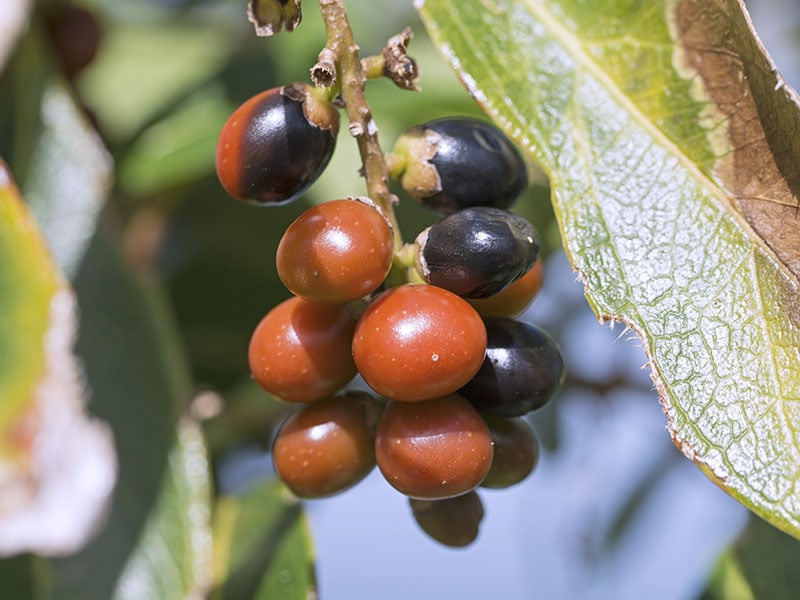
Guavaberry, also known as rumberry or cambuizeiro, is a famous fruit from the Virgin Islands (Caribbean). They are the main ingredients in the Christmas drink from people in Central America and South America.
Besides liquor, people can use guavaberry to make other sweets like jam or jelly.
Same with grape and grapefruit, guavaberry and guava don’t share anything related. Guavaberry is rich in vitamin C, but its taste is super sweet. It has a glossy look with colors that can change variously from brown to pink.
10. Guarana
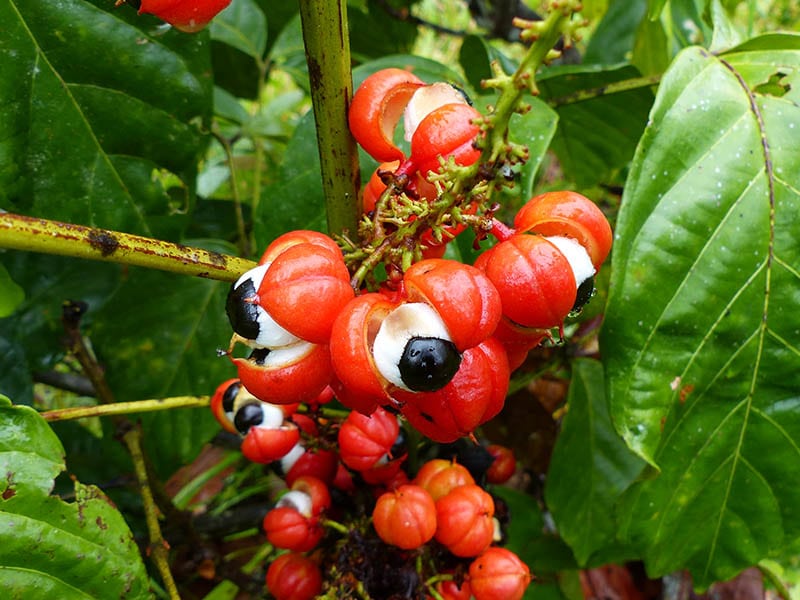
The first thing people can think of when they see these little fruits climbing along a tree branch is a stick full of eyeballs. Its name also came from that look since Guarana in Guarani means “the eyes of people.” Guarana is an especially popular fruit in Brazil.
You might have never heard of this fruit, but you might consume them every day. Production of Guarana is for making beverages, to be more specific, making energy drinks. Nobody eats this fruit fresh. What they want is its seed, where all the nutrients gather.
Just like coffee beans, Guarana seeds are enriched with caffeine and tannin. These seeds boost your concentration; therefore, it makes you feel less tired and helps you study better. People with constipation and diabetes can also use this fruit to ease their problems.
Although this Guarana fruit sounds like a magical fruit, it can also cause the same side effects as when you consume too much coffee. The symptoms include anxiety, headache, shakiness, and heart palpitations.
11. Galia Melon
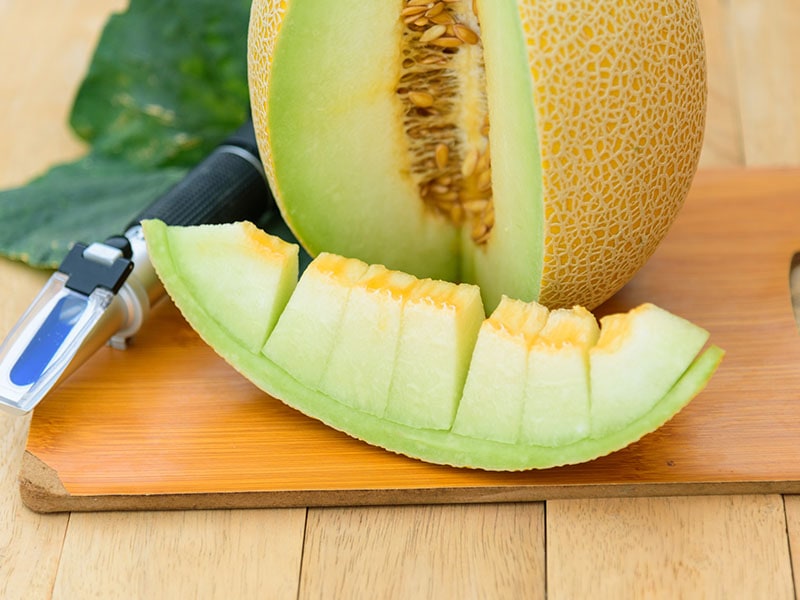
Have you ever wondered about the differences between honeydew and cantaloupe? An Israel doctor named Zvi Karchi thought so, and he also wanted to know if there was a hybrid fruit between these two.
He then introduced an Israeli honeydew (Ha-ogen) to a Russian cantaloupe, which later became the parents of Galia melon.
This delicious type of cantaloupe was bred to adapt to the especially dry agriculture of Israel. It is sweet and very aromatic. Some people prefer eating it raw. Some like to have Galia in their fruit bowl or salad.
Galia turns from green to yellow to indicate its ripeness, and you need to preserve it in the refrigerator.
This fruit is a great source of vitamin C and vitamin A. It also provides you with other nutrients like calcium, magnesium, and potassium. But there are some side effects if you consume too much Galia, like sugar overload or upset intestinal health.
12. Genip Fruit
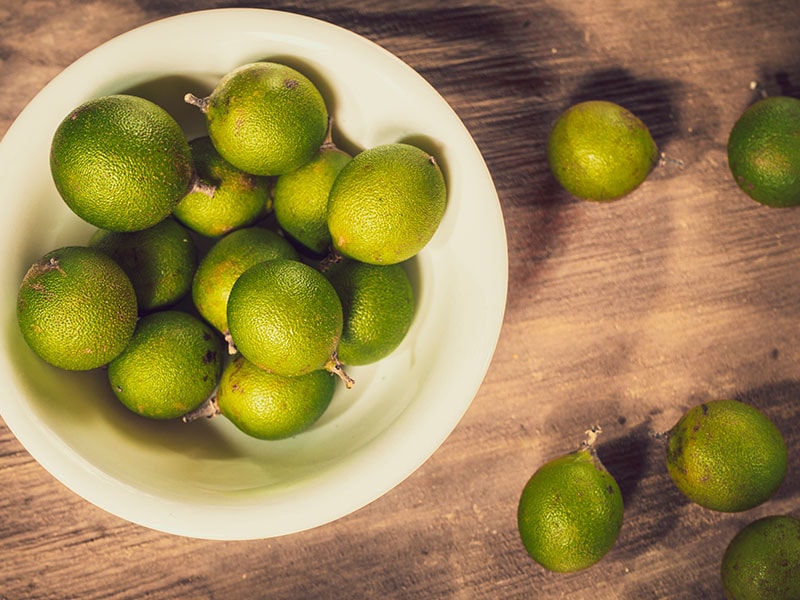
You can call genip fruit with other titles like skinip, huaya, mamon, honeyberry, or with its binomial name, which is Melicoccus bijugatus.
Covering itself with a firm dark green shell, genip fruit has tangy orange meat and white slippery seeds. Genip is a native snack from northern South America, and now it has spread to Central America.
Genip is a much-beloved street treat in Puerto Rico, where a special festival called Nacional de la Quenepa takes place annually.
There’s not much use for this fruit besides being a pocket food that people can enjoy fresh during dry summer days. Genip can be used to produce canned genip or beverages.
This fruit contains a lot of iron and phosphorus. But be careful with its juice when biting them; its juice stain is impossible to be cleaned.
13. Ground Plum
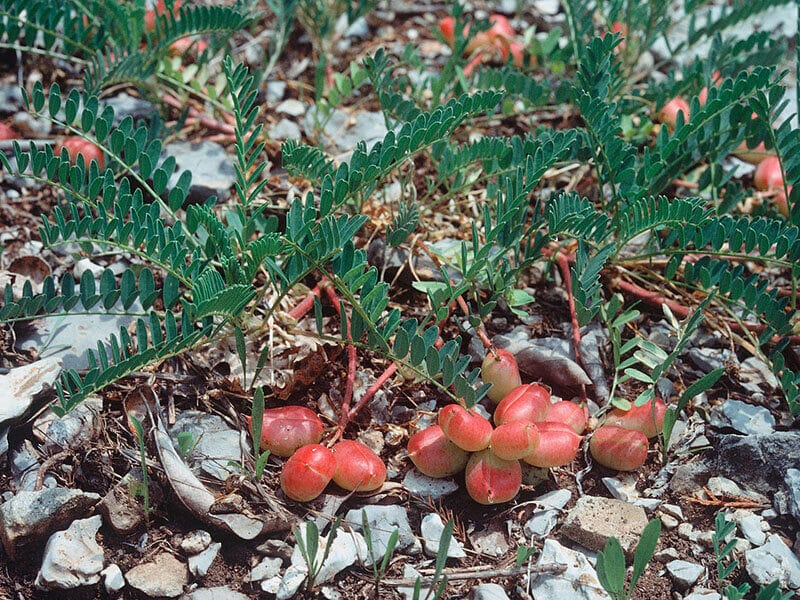
Ground plum is a favorite snack of prairies from North America.
Even though ground plum is a native North American fruit, not many Americans notice this kind of fruit before. Ground plum, or buffalo plum, is called “plum” due to the appearance of the fruit, but they don’t share the same genus.
It has smooth purple skin and the shape of a kidney. You can eat it raw or cook it when it’s unripe. People have described their taste as cooked peas or asparagus.
The prairie inhabitants use this fruit as horse medicine or cattle food. Although ground plum is edible, the rest of the plant is poisonous.
14. Grand Nain Banana
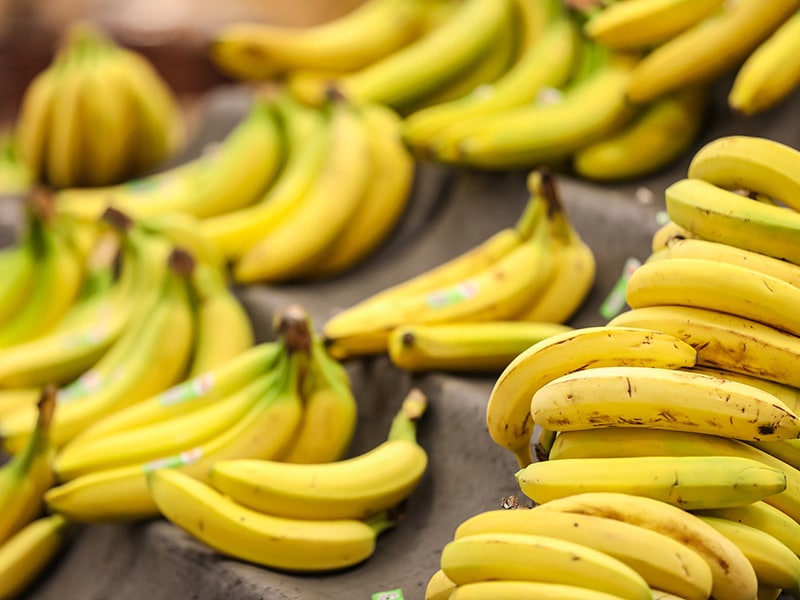
You might have never heard of this name before, but Grand Nain is extraordinarily famous. This variety of bananas and the Dwarf Cavendish cultivar are the two most popular banana species in the USA market.
Grand Nain can also be called Chiquita bananas since the Chiquita International Brand has it as their main product.
This lack of variety happened because of a historic banana crisis. In the 1950s, the main commercial cultivar at that time became almost extinct by Panama disease. After that, people had to grow Cavendish cultivars since these bananas have better resistance.
Grand Nain is sweet and has a thin peel. Banana, in general, is good for your digestion system. If you do work out daily, banana is the perfect food for you since it can resupply your body with electrolytes that you lose from sweating.
You can learn more about the history of bananas and how the Cavendish cultivar survived the crisis here.
15. Golden Kiwi
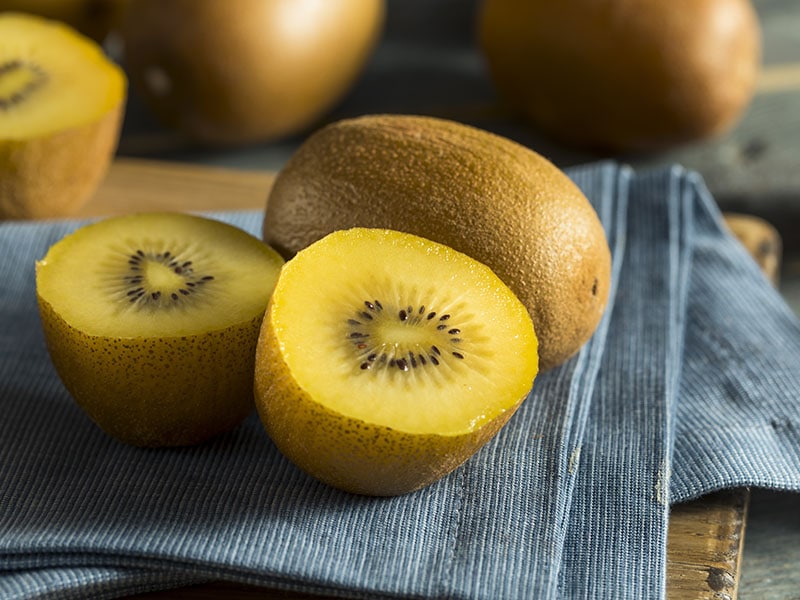
Many people notice golden kiwi because it’s so much sweeter than ordinary green kiwi. Not only so, some people even describe its taste as a tropical mixture of mango and pineapple fruits.
You can eat golden kiwi fresh, or like most people, they pair golden kiwi with herbs like mint or creamy fruits like bananas. Golden kiwi can also be seen in savory food like meat stew or be an ingredient in chutneys (a spicy South Asian sauce).
Golden kiwi was naturally bred in New Zealand, and now it is also known as Zespri Gold which is its commercial name. This fruit has low calories and can provide you with a lot of vitamin C and dietary fiber.
Here are some instructions for people who don’t know how to peel off and eat golden kiwi.
16. Goumi Fruit
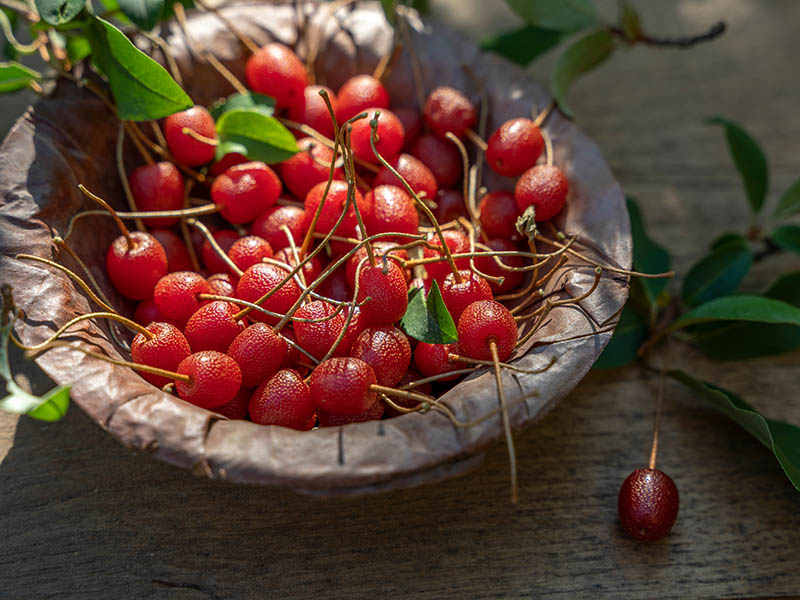
Goumi, or cherry silverberry, originates in East Asian countries like Japan, Korea, and China. This polished red fruit is not appetizing with its raw medicinal taste; it’s too tart and sour to enjoy. Goumi’s usage is to flavor liquor and vinegar or make desserts like jellies and jam.
Goumi and its family were first introduced to the West side of the world in the 1800s. This fruit is now a famous plant for ornamental purposes.
Mass cultivation can only be seen in its hometown. In Western like the USA or Europe, Goumi can only be seen in farmer’s markets. Goumi is categorized in the group of invasive plants by the USDA.
Fruits With G-Starts That You Might Not Even Know About
This section might probably be full of “strangers” to you. You might have seen their pictures on Facebook or Instagram before but did not bother to check them out. Here are eight more fruits that you might not know at all. It will be fun to learn more about them.
17. Gamboge Fruit
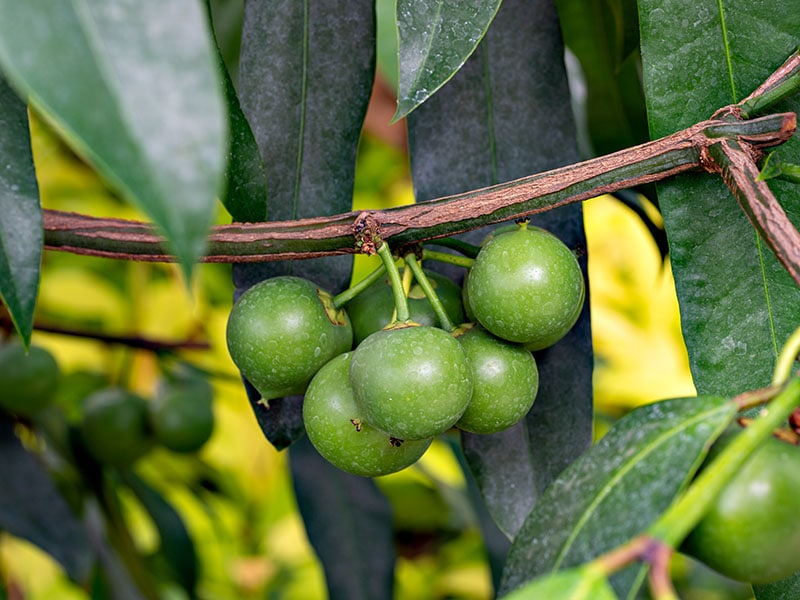
Coming from Southeast Asia, this tropical fruit is not people’s favorite. It’s sour and hard when it’s green; softer, sweeter, and more watery when yellow. Gamboge’s seeds are brown and oval, and they are very slippery.
Gamboge fruit is rich in vitamin C and fiber. It can be served fresh or cooked to make jam or chutneys. People can use it to ferment wine or vinegar as well.
Now, Gamboge fruit also grows in Australia and Florida, but it’ll be a challenge for you to find it in your local market.
Learn more about gamboge fruit’s taste and understand why it’s not a famous fruit.
18. Gac Fruit
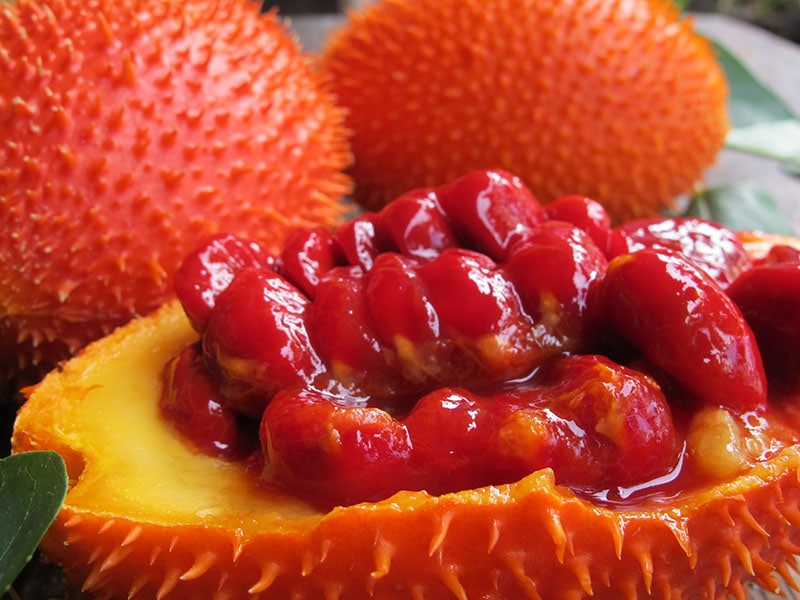
Gac fruit is a mini football ball covered in a bright red thorny coat that protects its slimy and edible sacs. Gac fruit is green when it’s immature. When it’s ripe, it owns a lively red color.
A native fruit from Vietnam, this fruit is barely consumed raw. Instead, people cook gac fruit with sticky rice. In Vietnam, it’s very disrespectful if there’s no sticky rice colored with gac fruit to offer to the ancestor on special occasions.
Gac fruit is not only just a good-looking fruit, but it’s also extremely nutritious. Many manufacturers use them to make beverages or dietary supplements.
19. Granadilla
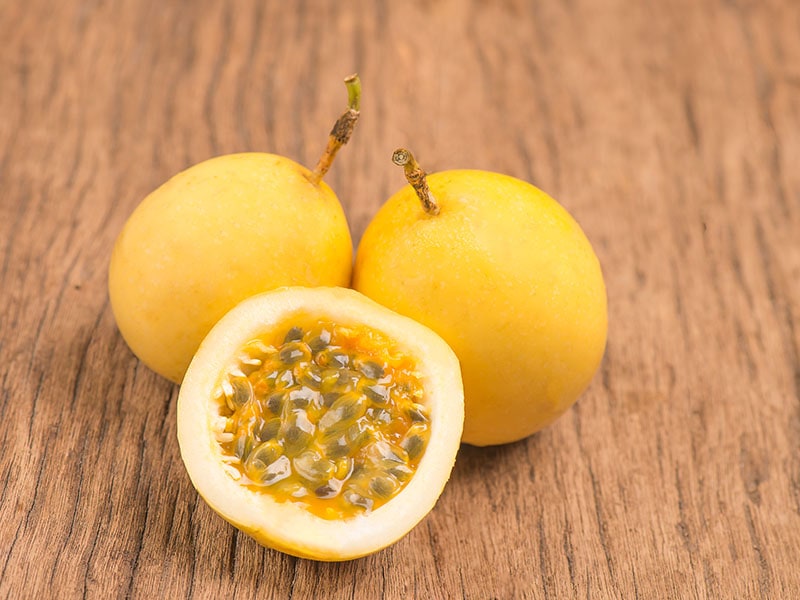
Also known as granadia, this tropical cousin of passion fruit shares a lot of similarities with its cousin. It’s firm, thick, and green when it’s young. It gradually turns yellow along with its maturity. Under the shell is a watery translucent pulp with countless small, black seeds.
Granadilla is a native South American fruit. After the Spanish came to this place in the 16th century, they brought the fruit back to Europe. Now, you can find it and its relations anywhere in the world.
Granadilla’s juice is sweet and sour and extremely fragrant. People use it to flavor drinks or make desserts like cakes or sorbets. The pulp is rich in vitamin C and vitamin A, which are very good for your immune system.
You can learn more about granadilla (sweet passion fruit) and its nutrient potential here.
20. Governor’s Plum
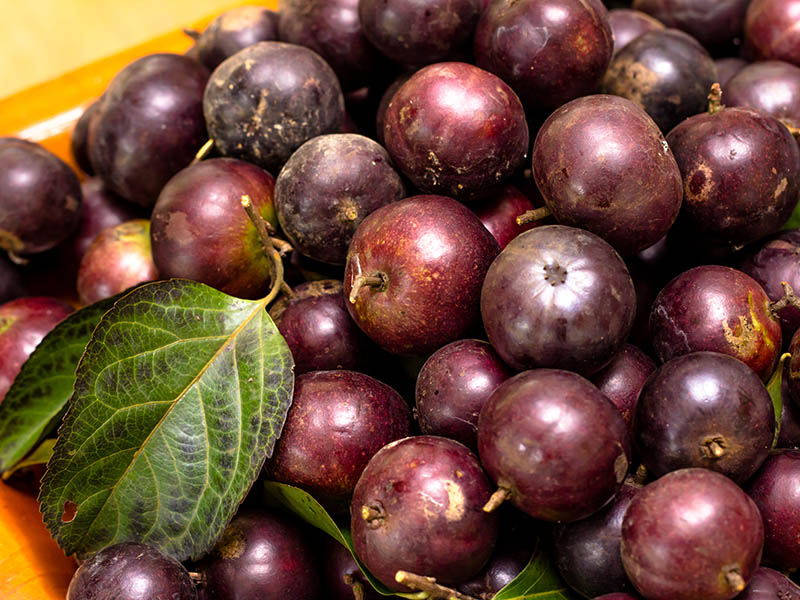
People call Governor’s plum by other names like ramontchi, Indian plum, or Madagascar plum. It originated in Africa and Asia and then was introduced to Florida in 1923 from India.
Now, it has been cultivated in Florida, but Governor’s plum is also considered an invasive weed in some parts of the state. While this type of plum seems like a nice fruit to have in your garden, you still should be careful with its invasive nature.
Governor’s plum is on the list of harmful introduced species, and people are trying to restrain its expansion. However, people really enjoy eating this fruit due to its fresh and sweet taste. They can make jam and wine with Governor’s plum.
21. Guabiroba/ Gabiroba
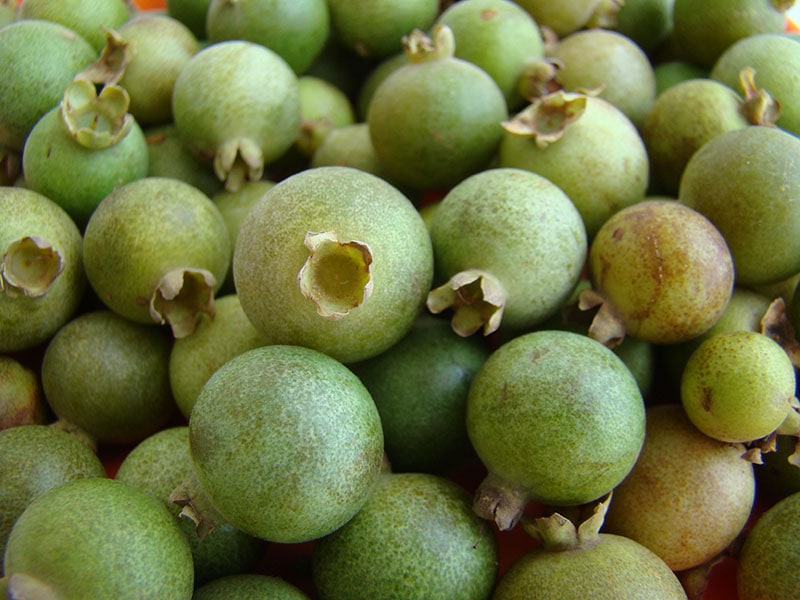
This Brazilian fruit is not a mass cultivating fruit. It’s also a cousin of guava, but they are so much different in shapes and flavors. Gabiroba has a thin, inedible yellow skin; its flesh is sweet and soft with edible seeds.
Gabiroba can be used to make sweet desserts or to flavor ice cream. People from South America have grown this plant for centuries, but now it’s jeopardized by the cultivation of soybean.
You can only find this fruit from online sellers or some local markets in South America.
22. Grumichama Fruit
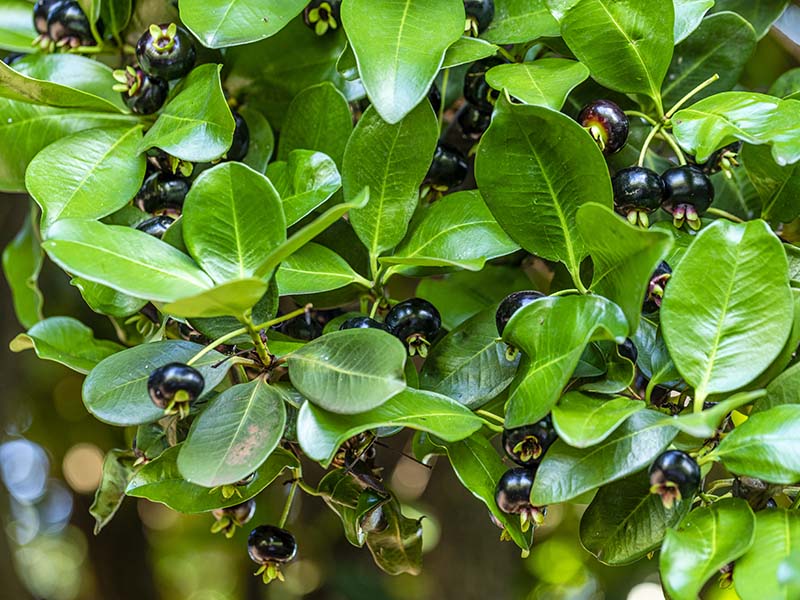
Grumichama, or Brazilian cherry, is another infamous fruit coming from Brazil. You can taste a mixture of cherry and plum flavors from this fruit. It is black and soft with a flossy look when it’s ripe.
Since Grumichama has so little meat, it is not an enjoyable snack for people. People grow this plant, mostly because they are into Grumichama flowers more than for tasting the fruit’s pleasant meat.
23. Guanabana Fruit
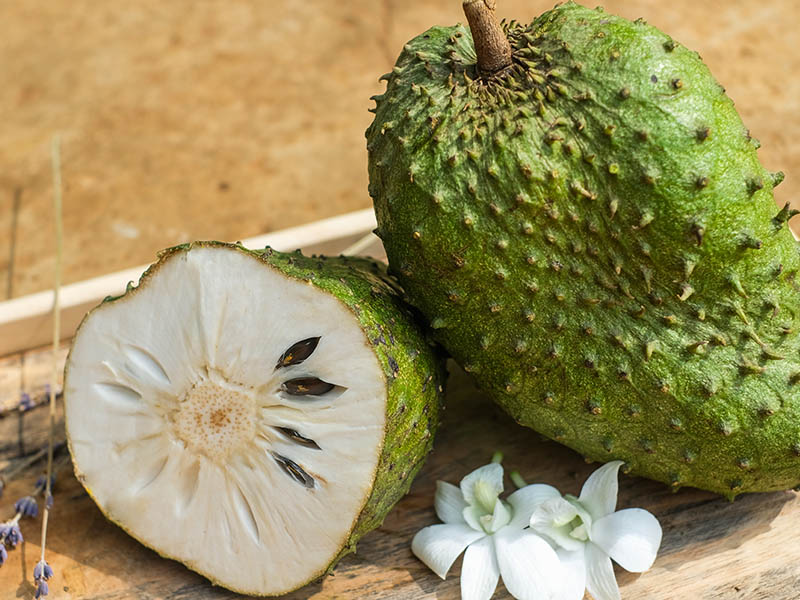
You might know this fruit as soursop or graviola, but you probably can’t predict that it has a Hispanic name as well, which is guanabana. Like jackfruit and gac fruit, guanabana wears a green firm thorny coat, so other animals can’t eat its meat before its maturity.
Guanabana was initially discovered in West Indie and South America, but after people brought it to the East, you can now find it everywhere.
Guanabana is so nutritious that some people say it’s an alternative cure for cancer even though so far, there’s no evidence for this statement.
You can eat guanabana fresh, but it’ll be so much tastier if you make a smoothie or ice cream out of it. It’s a popular ingredient in Champus – a well-known Peruvian dessert made from various fruits.
You need to be careful as well since its seeds are poisonous. Therefore, you should remove all of the seeds before juicing or blending.
Here’s a guide to teach you how to properly cut this fantastic guanabana.
24. Giant Lau Lau
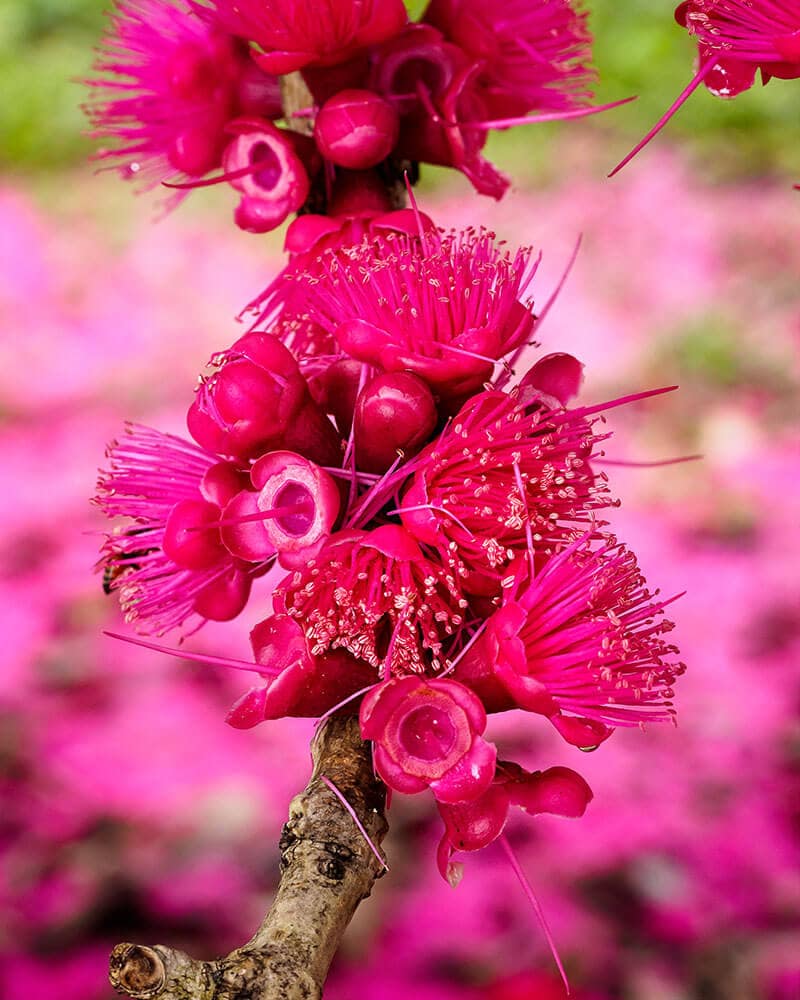
With a very interesting name and look, this Papuan fruit is all over New Guinea and some South Pacific islands. It’s hard for you to find it on other continents due to its lack of commercial potential.
Giant Lau Lau does not have anything extraordinary or spectacular compared to other relatives in the Syzygium family. It has a crispy texture, but its flavor is bland.
The Giant Lau Lau tree can be a nice decoration for your garden. But other than that, it has nothing except a name that starts with the letter G.
Now, Your Horizon Has Been Widened
I hope that you have learned a lot of things throughout your journey of fruits that start with the letter G. It is always so fun to gain more pieces of knowledge. What do you think about this list? You can express your thoughts in the comment section below.
Thank you for reading the post. Don’t forget to share this post with your friends and family since this can be a nice topic to chat about. Have a nice day, and stay curious!
